|
Rochelle
and I spent 12 sunny (see all the blue skies in the pictures?) and warm
days in the southern states of Mexico: Tabasco, Chiapas and Oaxaca.
Our nice husbands stayed at home while we were off gallavanting on a
much needed break. While it was wet and gloomy in Seattle, we thought
that it would be nice to enjoy a different kind of February weather.
With no itinerary planned, we showed up in Villahermosa, with just the
lonely planet and our backpacks.
Click on the thumbnail if you'll like to see the full size of the picture.
They were all taken with the Canon G3. We purchased this camera recently
to use on our world trip, and using it in Mexico was a good test of
its ease of use and quality of the final shots. I hope you enjoy them!
|
|
|
This was our arrival and departure point. In
hindsite, if we had actually planned an itinerary, we probably could
have made better use of our time by flying out of Mexico City on the
return. Instead, we had a 15 hour bus ride back but that's another
story. :) Villahermosa is a fairly wealthy city, especially in the
southern states which are considered the poorest parts of the country.
It's wealth is due to the oil deposits in the area. We enjoyed the
clean pedestrian walkways, the outdoor street vendors and the wonderful
evening breeze on the pedestrian bridge. The biggest attraction in
this city is the Museo Parque La Venta, which consists of monuments
found at the Olmec city of La Venta, which is situated near the Tabasco/Veracruz
border.
|

Jaguars, worshipped by many ancient Central and South American civilizations |

Monkey looking at the sky aka God of Fertility |
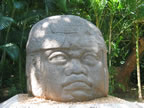
Olmec Head - 20 Ton!
|
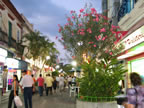
Pedestrian Mall - quite lively in the evenings! |
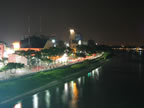
A 15second shot taken from the Pedestrian bridge - it was very pleasant
to be out here |
|
The town of Palenque is very small; most of the
stores here catered to tourists though there were so few gringos around
when we were there. Ever since the ruins have been made famous, Palenque
became a spot on the map. We enjoyed lots of mangos here, and the
best jugo de naranga. Leaving Palenque though, was an adventure in
itself (long story) but the moral of the story is, when in Mexico,
always go to the ADO station (first class bus line).
Our second day there, we took a 14hour long tour
visiting both Yaxchilán and Bonampak. In addition to our driver
Enrique, we were joined by tourmates from Holland, Spain, Canada,
Italy and Acapulco. We first stopped for breakfast in a restaurant
that is in the middle of a jungle; after clearing with the military
(everyone has to register to travel down that road), we drove off
to a small town to board the long boats to Yaxchilán.
Yaxchilán - Set up high
in the mountains, and looking across at Guatemala, this was a perfect
pilgrimage setting for the Lancandones. To get here, we had to ride
down the Rio Usumacinta on a motor boat (45 mins there, 1 hour back).
The jungle was peaceful, except when the howler monkeys throw branches
and twigs down at people from the top of the trees.
|
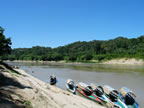
Guatemala is just across the river |
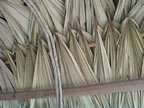
Interesting roof pattern on the motor boats |
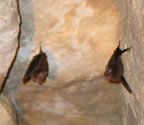
Murcielagos inside building #13 (also called the Labyrinth or the Maze)
|
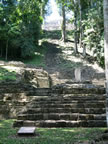
Steep walk up to the Grand Acropolis |
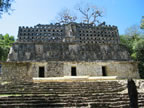
Grand Acropolis - see the body sitting up top? |
Bonampak - right next to a Lancandon
village, these ruins are famous for the murals on the interior walls
of one of the buildings ; it is considered one of the greatest battle
painting of pre-Hispanic Mexico. We rode on an open bus-type vehicle
from the entrance to the village. It was very dusty there, but the
grass and jungle were lush. Lots of mosquitoes as everyone hurriedly
applied their insect repellent when we arrived.
|
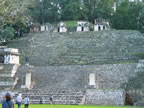
Bldgs 8,7,6,5,4 and 9
|
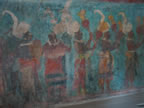
One of the three beautiful murals |
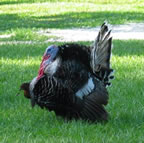
This turkey (and others) were strutting around showing off |
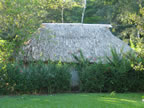
Cute Lancandon village house |
|
Palenque Ruins - one of the
best preserved Mayan ruins in Mexico. We spent 4 hours here, in awe
of the grandeur of the place. Unfortunately for Jen (probably luckily
for Rochelle) :) the Temple of the Inscriptions was closed off to
the public so we were unable to ascent to the top. This was probably
the hottest part of our trip - everyone had to take refuge in the
shade from the noon sun.
|

A Mayan symbol |

The Plaza - the Temple of the Inscriptions on the left, and the Palace,
with the four-storied Palace Tower on the right |

These buildings are a part of the Group of the Cross, and lie up in
the hills overlooking down at the Plaza
|
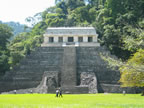
Temple of the Inscriptions |
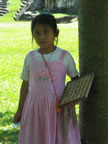
A little girl selling clay bracelets |
Cascadias - These two sites
are within 1.5 hours drive from the city of Palenque. Mizol-Ha consists
of a very tall waterfall, with several smaller ones nearby where people
dove into the pool below. There was a funny sign there that said that
all shoes and clothing must be removed before jumping into the water.
Hmm.... Agua Azul was quite amazing in comparison - beautiful turquoise
clear water, and impressive waterfalls. We spent a couple of hours
here soaking in the water and watching the local kids enjoy an afternoon
swim. On this trip, we met a nice young man, Lorenzo, who was an Irish
Mexican - very interesting mix, eh? We enjoyed his company tremendously.
|
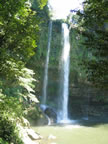
Mizol-Ha |

Agua Azul - the water was very clear and cool |
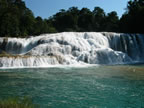
One of the many waterfalls at Agua Azul |
|
|
|
San Cristobal was a welcome change from the hot
and humid Palenque. Situated 7,000 feet up in the mountains of Chiapas,
the weather here is constantly cool and very pleasant. Colonial architecture
was all over the city, and I had a hard time letting my camera stay
in the bag. At the zocalo, we see many Indian women with their children
(mostly girls) walk around selling their wares. They all wear their
traditional costumes, so it is easy to spot them. The bad part is
that many young ones have learnt to ask for money, and in one case,
they almost tricked us into giving them $ (for school books, ya right).
The Lonely Planet recommended that we show up
at the Zocalo in the morning, and look for a woman carrying a golf
umbrella. Sure enough, we met up with Mercedes (as did several others),
who tooks us on a 5 tour to two of the neighbouring villages:
San Juan Chamula and Zinacantan. The people here are Tzotzil Mayan
Indians. In Chamula, it has a church made famous for its unique way
of blending traditional Maya beliefs with Catholic practices. People
come to the church and talk to the Shamans about their problems. In
both these villages, cameras were not welcome, and especially no pictures
allowed of their religious and political leaders. Mercedes was very
entertaining, and informative.
|
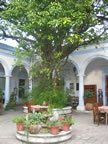
We had a nice dinner out here at a courtyard restaurant |

No significance other than the fact that I liked the door and its frame |
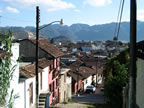
Looking down at the rooftops of the houses in the Central area |
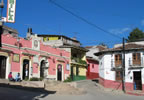
Doesn't this look like it could've been in any Italian village? |

Rochelle distracted many kids with bubbles (this little girl had been
trying to sell us scarves) |

Mercedes, our guide |
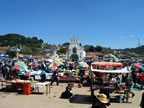
Sunday market at San Juan Chamula (there's the church in the background) |
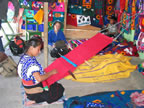
We watched a Zinacantan woman weave |
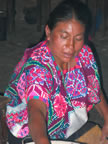
This nice Zinacantan woman made us queso tortillas - yummy! |
|
|
We arrived in Oaxaca at 9 in the morning, and
at 10, we were already on board a tour to Mitla (crazy, eh?). In case
you're wondering why I'm wearing a black longsleeve shirt under the
hot sun, that's why! Mitla was considered a Place of the Dead by the
Zapotec Indians. As ruins, it is worth visiting for the beautiful
architecture, a construction made to withstand earthquakes. We were
told that the tiled mosaics were built with no plasters or cement
to hold them in place, thus there is no room for movement on any part
of the heavily constructed walls. On the way to Mitla, we visited
the El Tule, a 2000 year old Juniper tree, supposedly with the largest
trunk circumference in the world, and Teotitlan del Valle, the village
of weavers.
|

El Tule |

Teotitlan del Valle |

Teotitlan rugs - our Canadian tourmates bought the second one from the
right (after much haggling) |
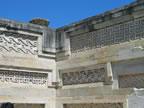
Mitla - look at the beautiful mosaics - many rugs and paintings were inspired
by these geometrical designs |

Hot, but happy to be get a chance to see this place of history |
Iglesia de Santa Domingo - Oaxaca's
most famous church. It was built in 1575, and has 6.5' thick walls
to make it earthquake-proof (I thought this was an interesting fact).
The interior is decorated with lavish gold ornaments, making it one
of the more impressive churches of Mexico. There is a botanical garden
within the church complex, and we were told that every species of
cacti found in the state of Oaxaca is grown here.
|
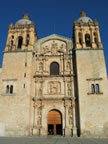
|
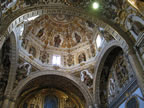
|

|
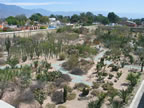
|
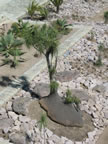
|
Monte Alban - the ancient capital
of the Zapotecs and a major city from 500BC to 800AD. The ruins have
been partially restored by archeologists in order that we have a better
understanding of the grandeur of this historical site. It is extremely
large, and I read somewhere that as many as 100,000 people used to
live here. As a city up high in the mountains, it had the advantage
of looking down at, and controlling the politics, economics and ideology
of the surrounding communities.
|
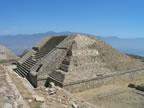
Partially restored pyramid |

Who's this person blocking the view of the Great Plaza?! |

One of the many carvings still found on the facade of these buildings |
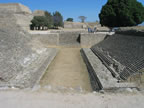
Ball Court - we seem to see one at all the ruins, whether it's Mayan or
Zapotec |
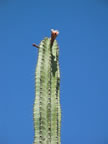
Tiny flower on a tall cactus |
Around town - We enjoyed walking all over town,
particularly up and down the Pedestrian Walk toward the Zocalo. The
architecture of this city was amazing, and so was the weather! I would
say that this was our favorite city on the whole trip. We would highly
recommend Oaxaca to anyone who is visiting Mexico. Good food (must
try the mole), and good sights. Of course we had to go visit the public
library while we were here; they still use card catalogs, separated
by titles, authors and subjects. It was exciting to see that they
also used the dewey decimal system (I looked up a chemistry book)
- sorry for being a nerdy librarian. I thought I would practice for
our big trip.
We spent a long time at the Mercado de Abastos,
a huge market where you can buy EVERYTHING! The market is organized
by type - i.e. all the fruits were together, meat, pottery, etc. It
was huge. We walked for hours and didn't see it all. Of course, after
a while, everything seems to look the same. After visiting several
other mercados for food and crafts, we enjoyed two wonderful museums.
The first is the Regional Museum of Oaxaca (housed in the Santa Domingo
Church complex); it has a great collection of artifacts from Monte
Alban. The second is the Rufino Tamayo Museum; a wonderful collection
of pre-Hispanic art in the country home of the eminent Oaxacan artist,
Tamayo. Of course, since Oaxaca is also known for its chocolate, we
paid a visit to their famous chocolate house, the Mayordomo, where
we sampled some of their wares (we had to be polite, you know).
|
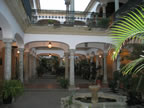
Oaxaca Public Library - nice eh? |
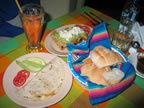
We really enjoyed this vegetarian restaurant - Cafe Flora |
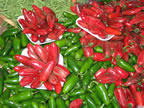
Peppers! |

Lots of veggies, and cheap too!! |

It was difficult to resist these beautiful pottery pieces |

Enjoying lunch with Keiko, whom we met going to Mitla |

Ah - I just loved the colonial architecture! Don't you like the colors
too? |
|
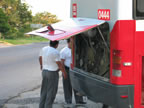
Our bus broke down on our way back to Villahermosa |
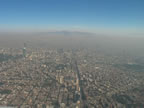
Flying over Mexico City |